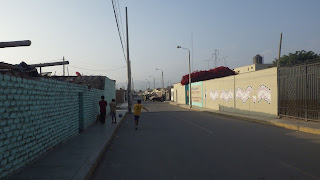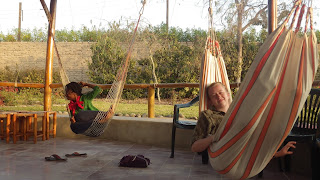The IFSA gang headed a couple of hours south of Lima to the
province of Chincha for a relaxing “fin de semana” before the madness of final
exams. We stayed in the sleepy district
of El Carmen, an area known for its Afro Peruvian population. Due to an earthquake in 2007 that devastated
the area, the town wasn’t really much to speak of. But our hotel on the outskirts of the
“pueblita” had a pool and served up really tasty traditional food; probably the
best “papa a la huancaína” that I’ve eaten yet and the “carapulcra y sopa seca”
was truly worth writing home about.
Plaza Central
Fun in the streets
Acá la gente come gatos...
Its always a little weird to transition from my life in Lima
to the tourist experience in the provinces; for me, its like a little bought of
cultural shock every time. These days, I
feel more like a local than anything else, but every time I leave the city I am
reminded once again of the fact that I am and always will be a “gringa”. When you travel, in any country, your
interactions with locals are part of a business transaction; as such, it’s hard
to relate with people as equals. The
rules of professional conduct, and certainly the important role that financial
transactions play, makes genuine and intimate interactions almost
impossible. For me it was a little strange
to be part of an American enclave staying in a walled and gated hotel on the
edge of El Carmen. Regardless, it was a
really fun trip; a good chance to breath clean air and see the sun. Things I
ordinarily take for granted, but that have become more and more of an uncommon
occurrence during the recent weeks.
IFSA love
Relaxation
A beautiful butterfly
We rolled out of Lima in our private bus on Friday during
midday. While traversing the narrow
streets of Chorrillos we celebrated the birth of IFSA student Sharene. As you can see the chocolate cake was
radically tasty. That night we ate a
delicious dinner and watched the Peru and Ecuador soccer game (Peru won
again!). Two of my friends were lucky
enough to be in the National Stadium for the game-I was super jealous!
On Saturday, I got up early to get some homework done before
the day. We had a brief informational
“charla” about Afro Peruvian history: http://centroafroperuano.blogspot.com/.
Peru has a large African population that can trace its origins to the
birth of the Spanish colony. The first
Africans in Peru were slaves that worked in agriculture or skilled labor. However, the take away point from our
conversation was that throughout their long history in Peru the African
population has contributed to Peruvian heritage in a myriad of ways. We learned about famous important Afro
Peruvian historical figures such as: San Martín de los Porres and Maria Elena
Moyana as well as the contributions of Afro Peruvians to Peruvian cuisine and
culture. Two instruments, the cajón and
the cajita, invented by Afro Peruvians are considered part of the Peruvian
“patrimonio nacional” (national culture heritage).
The cajón and the cajita in action.
After a delicious lunch, we headed to the Centro Cultural
Afroperuano to learn how to play cajón and dance zapateo. In Peru, the heart of the Spanish colony in
the Americas, the use and production of instruments was forbidden among
enslaved populations because music and dance are a pervasive way of
transmitting culture. To fill this gap,
skilled Afro Peruvian carpenters invented the cajón when they discovered the
percussive potential of furniture; it is now used in Spain in traditional
flamenco music. Another typical
instrument is the cajita, which is literally an alms box turned drum. Our teacher was Hector of the group Kimbafa: http://www.kimbafa.com/.
Zapateo
Group shot.
Cajón Circle.
Learning Afro Peruvian tap dance: zapateo.
We returned to our hotel to learn festejo. Our teacher was…intense; she split us into
two groups: guys and girls. She set us
up in a “u” so that everyone could see, but when I couldn’t stop laughing she
made sure that I was front and center.
Sharene, the only able bodied African American in our group, picked up
the dance with little effort. Thrilled with
her new student's progress our instructor asked Sharene to demonstrate and
referred to her new student as “mi sangre”.
Learning some new moves was fun, but watching the IFSA guys kill it on
the dance floor was even better. One of the guys,
the tallest and skinniest of the bunch, was having some trouble connecting with
his hips; upon seeing this, our dance instructor marched right over to help him
feel the music. After moving his hands to a more
intimate location on her hips she preceded to give him the lesson of a
lifetime; the only thing that he could do, while blushing, was remark,
“Claro, siempre es major con una chica.”
Festejo
Group shot.
Las chicas-trying to feel sexy and not laugh.
The lesson of a life time...
Hips don't lie
White boys can feel the music too
We closed the evening with a campfire and stories. Our guide told us a slew of traditional Afro
Peruvian fables in which animism played a prominent role. He was truly a talented storyteller, and I
found myself lost in the world of his tales.
We then translated American ghost stories into Spanish with varying
degrees of success.
Sunday morning before heading home to Lima we visited Huaca
la Centinela in Chincha Baja. Huaca la
Centinela was the principal settlement of the Chicha culture between 900 and
1450 AD; although conquered by the Inca in 1450, the Chichas retained some of
their autonomy. For this reason, Inca
and Chicha constructions exist in harmony in this site.
Just some gals and a Huaca
Earthquake evidence...
Inca constructions.
The day was as grey as the belly of the donkey, and I must
admit that I wasn’t overly thrilled at the idea of seeing yet another
archaeological site. However, it was a
nice chance to see the area, and a really interesting example of a poorly cared
for archaeological site. There is
clearly a huge diversity in funding and effort spent in maintaining Peru´s
cultural heritage; unfortunately, Huaca la Centinela is located in a zone that
doesn’t receive many tourists. As such,
it is poorly maintained; after the earthquake of 2007 it resembles little more
than a slowly eroding pile of clay capped in a tall wooden cross. But that’s not say that Huaca la Centinela is
not without charm; virtually vacant of tourists and subject to the slow erosion
of time this site is truly a city of ghosts.
View from the top
Besitos...
Politically correct?























No comments:
Post a Comment